
Orocrambus callirrhous is a moth in the family Crambidae. It was described by Edward Meyrick in 1883. It is endemic to New Zealand. It has been recorded from the eastern and central part of the South Island and the coast near Wellington and Whangārei on the North Island.
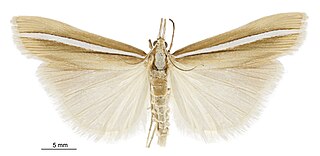
Orocrambus crenaeus is a moth in the family Crambidae. It was described by Edward Meyrick in 1885. It is endemic to New Zealand, where it is known from the South Island. The habitat consists of alpine grasslands.

Orocrambus cyclopicus is a moth in the family Crambidae. It was described by Edward Meyrick in 1883. In 1975 David E. Gaskin wrongly synonymised Crambus sophistes with Orocrambus cyclopicus.
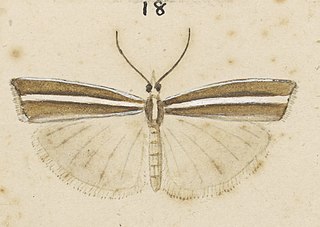
Orocrambus dicrenellus is a moth in the family Crambidae. This species was first described by Edward Meyrick in 1882 under the name Crambus dicrenellus. It is endemic to New Zealand. It has been recorded from the central part of the South Island.

Orocrambus enchophorus is a moth in the family Crambidae. It was described by Edward Meyrick in 1885. It is endemic to New Zealand. It has been recorded from the South Island and North Island. The lives in lowland to alpine grassland habitat.

Orocrambus ephorus is a moth in the family Crambidae. It was described by Edward Meyrick in 1885. It is endemic to New Zealand. It has been recorded from the South Island. The species' preferred habitat consists of alpine tussock grasslands.
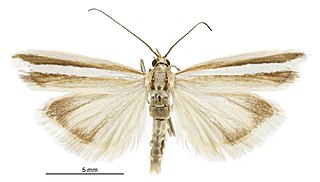
Orocrambus fugitivellus is a moth in the family Crambidae. It is endemic to New Zealand. It is classified as critically endangered by the Department of Conservation.

Orocrambus haplotomus is a moth in the family Crambidae. It was described by Edward Meyrick in 1882. This species is endemic to New Zealand. O. haplotomus has been recorded from the areas around Lake Te Anau and Lake Wakatipu in the South Island.

Orocrambus harpophorus is a moth in the family Crambidae. It was described by Edward Meyrick in 1882. It is endemic to New Zealand. The species has been recorded from the South Island and North Island.

Orocrambus horistes is a moth in the family Crambidae. It was described by Edward Meyrick in 1902. O. horistes is endemic to New Zealand, where it has only been recorded from the Chatham Islands.

Orocrambus isochytus is a moth in the family Crambidae. It was described by Edward Meyrick in 1888. This species is endemic to New Zealand. It is found in the Nelson area as defined by the Crosby codes, the New Zealand Area Codes for recording specimen localities. It has been recorded from Mount Arthur and Mount Peel. The habitat of this species consists of alpine tussock grasslands.

Orocrambus melitastes is a moth in the family Crambidae. It was described by Edward Meyrick in 1909. This species is endemic to New Zealand, where it has been recorded in Southland, Otago and Westland. It is found from the subalpine zone down to sea level.

Orocrambus paraxenus is a moth in the family Crambidae. It was described by Edward Meyrick in 1885. It is endemic to New Zealand, where it has been recorded from the South Island. The habitat this species prefers consists of dry tussock areas.
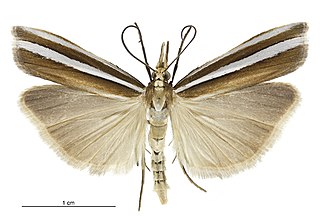
Orocrambus siriellus is a moth in the family Crambidae. It was described by Edward Meyrick in 1883. This species is endemic to New Zealand, where it has been recorded in Northland to Southland and on the Chatham Islands. It lives in habitat consisting of swampy areas.
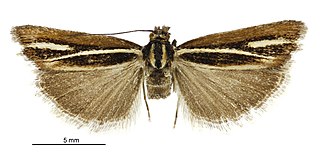
Orocrambus thymiastes is a moth in the family Crambidae. It was described by Edward Meyrick in 1901. This species is endemic to New Zealand, where it has been recorded from Southland. O. thymiastes prefers habitat that consists of boggy areas. This species is associated with Chionochloa rubra.

Orocrambus ventosus is a moth in the family Crambidae. It was described by Edward Meyrick in 1920. The species is endemic to New Zealand, where it has been recorded in the Tasman Mountains and at Mount Owen. Its preferred habitat is alpine grasslands.

Orocrambus xanthogrammus is a moth in the family Crambidae. It was described by Edward Meyrick in 1883. It is endemic to New Zealand, where it has been recorded from the South Island and the eastern part of the North Island. The habitat of this species consists of shingle river beds.

Glaucocharis elaina is a species of moth in the family Crambidae. This species was described by Edward Meyrick in 1882. It is endemic to New Zealand.
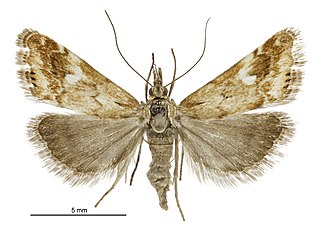
Glaucocharis helioctypa is a moth in the family Crambidae. It was described by Edward Meyrick in 1882. It is endemic to New Zealand.

Glaucocharis leucoxantha is a moth in the family Crambidae. It was described by Edward Meyrick in 1882. It is endemic to New Zealand.





















